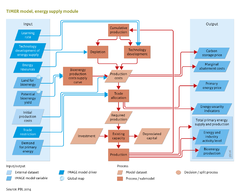Energy supply/Policy issues: Difference between revisions
Jump to navigation
Jump to search
m (Text replace - "|Status=On hold" to "") |
m (Text replace - "Roads from Rio+20 (2012)" to "Roads from Rio+20 (2012) project") |
||
| Line 3: | Line 3: | ||
|Reference=PBL, 2012; | |Reference=PBL, 2012; | ||
|Description=Under the baseline scenario, demand for energy increases, rapidly. As a consequence, supply is projected to increase over the next decades, for all energy supply options. Under the baseline scenario, energy demand is mostly met through fossil fuels. At the same time, important shifts in dominant energy carriers and main supply regions are projected. For coal, the model indicates a continuous rise in production, mostly in the regions that already produce the largest shares of global output. For oil, the model also shows a continuous production increase for the next decades, with an increasing role for unconventional sources. The last mainly come from Canada and South America. Natural gas is expected to show a faster rise in production, as it is presumed to be more abundant and increasingly cost-competitive. Here, too, unconventional sources will become more important. Main gas producers are the United States, the former Soviet Union and increasingly also the Middle East. Production of modern types of bio-energy is constantly increasing – and in different parts of the world. For solar and wind, the most rapid increase, so far, has been in western Europe, the United States and China. For the future, also certain parts of South America and India are expected to start producing large amounts of renewable energy. Nuclear power is expected to remain roughly at the same level, and uranium production remains more or less stable and rather evenly distributed across world regions. Finally, hydropower capacity, under the baseline scenario, shows a modest increase. | |Description=Under the baseline scenario, demand for energy increases, rapidly. As a consequence, supply is projected to increase over the next decades, for all energy supply options. Under the baseline scenario, energy demand is mostly met through fossil fuels. At the same time, important shifts in dominant energy carriers and main supply regions are projected. For coal, the model indicates a continuous rise in production, mostly in the regions that already produce the largest shares of global output. For oil, the model also shows a continuous production increase for the next decades, with an increasing role for unconventional sources. The last mainly come from Canada and South America. Natural gas is expected to show a faster rise in production, as it is presumed to be more abundant and increasingly cost-competitive. Here, too, unconventional sources will become more important. Main gas producers are the United States, the former Soviet Union and increasingly also the Middle East. Production of modern types of bio-energy is constantly increasing – and in different parts of the world. For solar and wind, the most rapid increase, so far, has been in western Europe, the United States and China. For the future, also certain parts of South America and India are expected to start producing large amounts of renewable energy. Nuclear power is expected to remain roughly at the same level, and uranium production remains more or less stable and rather evenly distributed across world regions. Finally, hydropower capacity, under the baseline scenario, shows a modest increase. | ||
|Example=The figure below shows how the introduction of stringent climate policy influences the production of primary energy resources. Clearly, climate policy leads to a major shift, from a system that is mostly based on fossil fuels to an increase in the use of nuclear power, renewable energy, bio-energy and CCS technology, with a correspondingly lower reliance on fossil fuels. The choice of these alternative options depends on assumptions made in the model. In the different scenarios elaborated in the study ' [[Roads from Rio+20 (2012)]]’ ([[PBL, 2012]]), this has been shown in three pathways, which, based on different initial assumptions, emphasise the use of the different combinations of primary energy carriers, each time within a stringent emission constraint. | |Example=The figure below shows how the introduction of stringent climate policy influences the production of primary energy resources. Clearly, climate policy leads to a major shift, from a system that is mostly based on fossil fuels to an increase in the use of nuclear power, renewable energy, bio-energy and CCS technology, with a correspondingly lower reliance on fossil fuels. The choice of these alternative options depends on assumptions made in the model. In the different scenarios elaborated in the study ' [[Roads from Rio+20 (2012) project]]’ ([[PBL, 2012]]), this has been shown in three pathways, which, based on different initial assumptions, emphasise the use of the different combinations of primary energy carriers, each time within a stringent emission constraint. | ||
}} | }} | ||
Revision as of 15:46, 13 January 2014
Parts of Energy supply/Policy issues
| Component is implemented in: |
|
| Related IMAGE components |
| Projects/Applications |
| Key publications |
| References |
